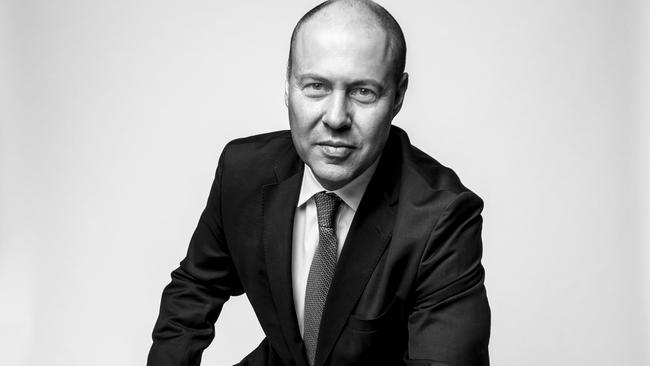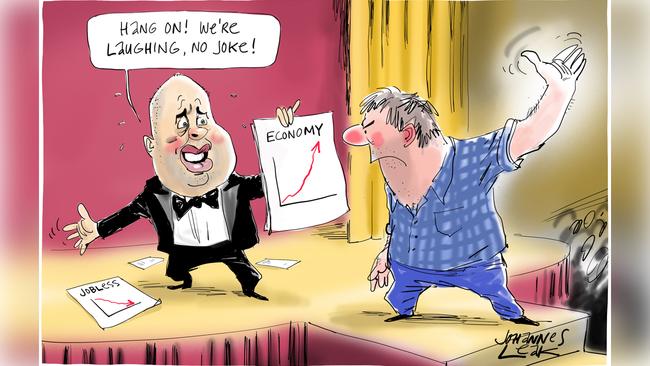Federal Budget 2022: Treasurer makes his pitch to middle Australia
Families, low-and-middle income earners and seniors will get $8.6bn in handouts, plus cheaper fuel, as the Coalition shapes its re-election push.

Josh Frydenberg has unveiled a 22c-a-litre cut to the petrol excise, tax breaks for low-and-middle income earners, and cash payments for seniors in an $8.6bn hip-pocket election-eve pitch to middle Australia.
The Treasurer said on Tuesday the Morrison government would halve the 44.2c-per-litre fuel excise for six months at a cost of $3bn to relieve pressure at the bowser and drive prices below $2-a-litre. The measure was due to come into effect at 12.01am on Wednesday and would flow through to the bowser within a fortnight.
With a May general election expected to be called next week, Mr Frydenberg urged voters to stick with the Coalition after being tested by “drought, fire, floods’’ and a global pandemic over the past three years.
“Despite the challenges, our economic recovery is leading the world,’’ Mr Frydenberg said. “This is not a time to change course. This is a time to stick to our plan.’’
More than 10 million low-to-middle income earners will receive a one-off $420 cost-of-living tax offset from July 1, while six million pensioners, self-funded retirees and welfare recipients will get $250 bonus payments before the May election.
The cost-of-living package, including the $4.1bn top-up of the low-to-middle income tax offset, will be taken to parliament on Wednesday with the government laying down a challenge for Labor leader Anthony Albanese to pass its budget measures.
The deficit falls to $78bn in 2022-23, $21bn less than forecast in December, as soaring tax receipts on the back of a stronger labour market recovery than forecast and record commodity prices drove a dramatic turnaround in the debt and deficit trajectory.
With the unemployment rate forecast to hit 3.75 per cent in the September quarter, Mr Frydenberg predicted a dividend of stronger wage growth that would outstrip inflation in the 2022-23 financial year. Inflation is due to peak this year at 4.25 per cent before falling to 3 per cent next year. The wage price index is expected to grow at its fastest pace in a decade over the next three years, rising to 3.25 per cent next year and 3.5 per cent by 2025.
Pledging more money for women’s security, aged care, health, education and life saving pharmaceuticals, Mr Frydenberg said the budget would guarantee essential services and drive business investment.
Delivering his budget speech in parliament on Tuesday night, Mr Frydenberg said, “we live in uncertain times” and urged voters to stick with the Coalition’s economic and security plan.
“As we gather, war rages in Europe. The global pandemic is not over. Devastating floods have battered our communities. The last two years have been tough for our country, there have been setbacks along the way,” Mr Frydenberg said.
He claimed the “largest and fastest” improvement to the budget bottom line in 70 years.
Mr Frydenberg said the economic rebound had been “nothing short of remarkable”.
“We have overcome the biggest economic shock since the Great Depression,” he said.
“Our recovery leads the world. The clear fiscal strategy that we put in place to avoid a scarring of the labour market has worked. Our budget has turned the corner. In this budget, we are banking the dividend of a stronger recovery.”
Mr Frydenberg said the budget bottom line would be $103bn “better off” compared with forecasts in December despite the government including more than $17bn in new spending policies, which are dominated by cost-of-living measures. Total new spending over four years totals $30.5bn.

The pre-election budget builds on key planks of the Coalition’s campaign strategy – a stronger economy, jobs, training, Defence and national security, health, supply chain resilience and women’s economic security.
It includes new tax incentives for small business investing in training, digital economy and cyber security, $6.5bn for skills, apprenticeships and training, $10.7bn for regional infrastructure including upgrade mobile coverage, $17.9bn for transport infrastructure and $525m for cheaper medicines.
Affordable housing projects received a $2bn boost and places in the home guarantee scheme were doubled to 50,000 places per year, helping single parents buy a home with deposits as low as 2 per cent. More than $6bn will be spent on flood-recovery measures and payments supporting families, farmers and small businesses in NSW and Queensland.
Framing his fourth budget around fiscal restraint, Mr Frydenberg said the $78bn underlying cash balance for 2022-23 was $20bn lower than the deficit forecast in December. He said the deficit bill as a share of GDP would halve over the next three years and net debt would peak in mid-2026 at about $865bn.
Treasury expects the budget to remain in deficit for at least a decade.
Despite unprecedented revenue surges, gross debt levels are still projected to reach $1.17bn within four years. Treasury figures reveal that over five years from 2021-22, the budget will bank $103bn in savings even after almost $17.2bn in spending for the upcoming financial year.
Mr Frydenberg said the budget reflected “the largest and fastest improvement to the budget bottom line in over 70 years”.
“By the end of the forward estimates, the budget is $100bn better off compared to last year. More people in work, fewer on welfare,” he said.
“Repairing the budget without increasing taxes. The deficit for 2022-23 is expected to be $78bn or 3.4 per cent of GDP. Over the next three years, this will more than halve to 1.6 per cent. Net debt as a share of the economy will peak at 33.1 per cent at 30 June 2026.”
The budget, which allocates almost $10bn over a decade to support new Australian Signals Directorate cyber warfare capabilities, does not lift the long-term trajectory of the Defence budget significantly above 2 per cent of GDP despite growing strategic threats.
The fuel excise reduction is expected to shave one-quarter from current inflation levels, with lower prices due to kick in within two weeks. Inflation is predicted to fall to 3 per cent in the next financial year and 2.5 per cent by mid-2026.
Mr Frydenberg said his “temporary, targeted and responsible cost-of-living package” would ease pressure for Australians facing higher fuel, food, and shipping costs.
“For the next six months, Australians will save 22c a litre every time they fill up their car,” he said. “A family with two cars who fill up once a week could save around $30 a week or around $700 over the next six months. Whether you’re dropping the kids at school, driving to and from work or visiting family and friends, it will cost less. This cut in fuel excise, which takes effect from midnight tonight, will flow through to the bowser over the next two weeks.”
Mr Albanese will unveil new Labor election policies in his budget reply speech on Thursday, the last sitting day before the May poll, and was not expected to stand in the way of the government’s cost-of-living measures.
The 72-page women’s budget statement, outlining $2bn in spending on women’s economic security, health and safety, is headlined by a pre-election sweetener for young families after the government announced it would allow mums and dads to “decide how they will share” paid parental leave.
Mr Frydenberg said “families, not government are best placed to decide what works for them”.
After baking in low assumptions for iron ore, coal and LNG prices, Treasury said that if global prices remained at record levels through to the end of September, tax revenue would be almost $30bn higher.
Treasury’s Covid-19 assumptions, which were up-ended in the last two budgets, are that community transmission will continue to occur and a further Omicron wave is expected during winter.








To join the conversation, please log in. Don't have an account? Register
Join the conversation, you are commenting as Logout